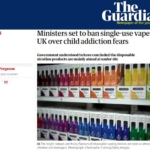The alarming prevalence of smoking in Pakistan casts a long shadow over its public health and economic prosperity. With a staggering 24 million active smokers, the country is grappling with multiple smoking-related diseases, including heart disease, chronic obstructive pulmonary disease, lung cancer, stroke and tuberculosis. The heavy burden on the health care system leads not only to loss of life, but also to significant economic losses.

Despite efforts to curb smoking, Pakistan has yet to achieve its tobacco control goals and existing methods appear outdated and ineffective. However, a silver lining comes in the form of tobacco Harm Reduction (THR), with the introduction of nicotine pouch as a viable alternative.
According to the recently released global report entitled “Integrating Harm Reduction into tobacco Control,” THR interventions, including the promotion of nicotine pouch, are expected to reduce premature deaths from smoking. These bags provide smokers with a smoke-free experience that satisfies their craving for nicotine without the harmful effects of burning.
The report paints a compelling picture of the potential impact of THR in Pakistan. If nicotine pouch are adopted across the country, the current smoking rate (a worrying 34.3 percent) could fall to just 8 percent by 2045 and further to 5 percent by 2060. This means a significant reduction in the number of smoking-related deaths from 163,000 per year to 114,000 in 2045 and 76,000 in 2060. Moreover, the economic cost of smoking in Pakistan is staggering at Rs 615.07 crore ($3.85 billion), equivalent to 1.6% of the country’s GDP.
Salman, a former smoker from Lahore, reflected on the experience of using nicotine pouch after quitting. “Adopting a nicotine pouch was transformational for me, especially given the damage smoking did to my lungs. I used to suffer from breathing problems and a constant heaviness in my chest from smoking. But since switching to nicotine pouch, I’ve noticed a significant improvement in my respiratory health. I strongly believe that these new products have the potential to help people switch to less harmful products, “Salman shared.
However, the road to a smoke-free future is not without obstacles. Despite evidence of the efficacy of tobacco harm reduction products, policymakers have been hesitant to embrace them. To address this challenge and minimize smoking rates, a multifaceted approach is needed. Tax relief for THR alternatives should be given to support their accessibility and adoption.
Promoting alternatives such as nicotine pouch could reduce the economic burden of smoking in Pakistan by reducing the medical costs associated with treating smoking-related diseases. By encouraging the adoption of such smoke-free products, policymakers can redirect resources to other sectors of the economy.




